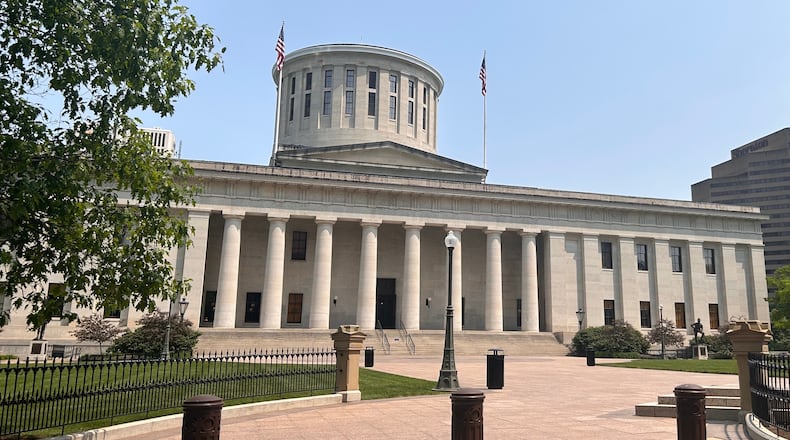So why do Ohio voters have to approve borrowing money for roads and bridges, but not for a football stadium? How does government debt work on the state level?
Our Inside Ohio Politics series seeks to demystify the workings of Ohio’s state government. This week, we look at state borrowing and debt.
Government debt
The federal government routinely operates at a deficit. Federal lawmakers are currently debating a tax and spending bill that could increase the national debt by trillions of dollars.
The state of Ohio can’t do that. The Ohio Constitution requires the state to have a balanced budget.
This doesn’t mean Ohio doesn’t have debt. The state can borrow money in certain limited circumstances by issuing bonds.
This news outlet spoke with former Ohio Gov. Bob Taft, a Republican who led the state’s executive branch from 1999 to 2007, to explain how bonds work and how the state tends to use them.
So, what are bonds?
Bonds allow governments to borrow large amounts of money at a given time and then repay the lender over time with interest.
The benefit of a bond, Taft said, is that it gives the state the latitude to invest upfront in major projects and then pay those projects off over an extended period of time, often 20 to 30 years.
“It‘s like a home mortgage, basically. The state pays a little bit of interest and pays back principal over a period of years with constant payments,” Taft said. “The state knows what it‘s getting into, you know it‘s going to have to pay so much debt service each year on that bond, and that‘s a very small amount compared to the total amount of the bond, so that makes it affordable by stretching out the payment over a period of years.”
Note: Taft said the interest rate the state pays back on its bonds is related to its bond rating, or the proven ability the state has to pay back the money it borrowed. Ohio, as of late 2023, has the highest achievable bond rating from the major credit bureaus.
Who Ohio borrows from
“Anyone can buy these bonds,” Taft said, including big and small investors, investment funds, insurance companies, banks, even other governments.
Taft noted that bonds can be attractive to investors because, he said, federal law does not tax the interest people earn on state and federal bonds.
Limits on borrowing
Taft said that bonds have been a go-to tool for American governments since the start — from funding the American Revolution to helping finance canal systems and more.
“Early on, some of the states got into trouble, including Ohio. They issued more bonds than they should have, beyond their capacity to pay them off and meet their daily operating expenses,” Taft explained. “So then limits were placed into the state constitutions, usually by a public vote, on the amount of debt that can be issued.”
Here‘s Ohio’s limit, lodged in Article VIII, Section 1: “...the aggregate amount of such debts, direct and contingent, whether contracted by virtue of one or more acts of the General Assembly, or at different periods of time, shall never exceed seven hundred and fifty thousand dollars...”
But the constitution has been amended to allow borrowing over that amount in limited circumstances.
Issue 2
Issue 2 on the May 6 ballot would amend the Ohio Constitution to give the state express permission to borrow $2.5 billion through bonds for specific types of infrastructure projects.
The bonds, if approved by a simple majority of voters, would go toward the State Capital Improvement Program and could only be used on roads, bridges, water treatment and supply systems and solid waste disposal facilities, according to the legislature‘s nonpartisan analysis.
Ohio voters have routinely approved issuing bonds to fund SCIP since 1987, though this is the largest ask in state history. Issue backers — Issue 2 has bipartisan support and no organized opposition, and has been called indispensable by local county engineers — say the increase is needed because of inflation.
Issue 2 would not be used to fund the Browns stadium; that is a completely unrelated proposal in the state budget.
Cleveland Browns
The proposal to borrow money for the Browns is a bit murkier from a constitutional standpoint.
The Ohio House passed a draft two-year state budget including language giving the state authority to issue up to $600 million in revenue bonds — bonds paid back by the tax revenue generated from a specific project — for the Browns. The budget is now before the Ohio Senate.
The money is meant to supplement private investment in the organization’s quest to build a state-of-the-art facility in a Cleveland suburb. The plan is for the state to get the money back through revenue generated from the project.
In its workings, the House pointed to Article VIII, Section 2i of the state constitution, which generally sets out that the state can issue bonds for certain capital improvement. This is used for things like turnpike construction.
However, an analysis from the state’s nonpartisan Legislative Service Commission’s Legislative Budget Office noted that the section does not specifically say that a new professional sports facility may count as a capital improvements.
“Whether this means they are constitutional is an open question, and ultimately only a judge could make that determination,” the analysis reads.
For more stories like this, sign up for our Ohio Politics newsletter. It‘s free, curated, and delivered straight to your inbox every Thursday evening.
Avery Kreemer can be reached at 614-981-1422, on X, via email, or you can drop him a comment/tip with the survey below.
About the Author

